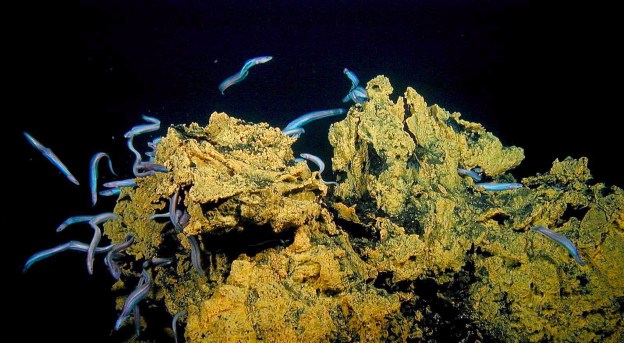Image from NOAA, in the public domain.
Last updated on March 16, 2018. I just finished a large project trying to estimate that. I’ve posted it on its own page here. Here’s the abstract:
We estimate that there are between 10^23 and 10^24 neurons on earth. Most of this is distributed roughly evenly among small land arthropods, fish, and nematodes, or possibly dominated by nematodes with the other two as significant contenders. For land arthropods, we multiplied the apparent number of animals on earth by mostly springtail-sized animals, with some small percentage being from larger insects modeled as fruit flies. For nematodes, we looked at studies that provide an average number of nematodes per square meter of soil or the ocean floor, and multiplied them by the number of neurons in Caenorhabditis elegans, an average-sized nematode. For fish, we used total estimates of ocean fish biomass, attributed some to species caught by humans, and used two different ways of allocating the remaining biomass. Most other classes of animal contribute 10^22 neurons at most, and so are unlikely to change the final analysis. We neglected a few categories that probably aren’t significant, but could conceivably push the estimate up.
Using a similar but less precise process based on evolutionary history and biomass over time, we also estimate that there have been between 10^32 and 10^33 neuron-years of work over the history of life, with around an order of magnitude of uncertainty.


Pingback: Rational Feed – deluks917
The use of fruit flies as an estimator for average # of neurons in insects seems very dubious: they have much bigger brains than the median insect (particularly if springtails and the like are included, as I think they are in the referenced estimate). The larger insects are correspondingly less common, so combining the total population # with such a large insect brain should really damage the estimate.
“I multiplied this by the number of neurons in a small insect, the fruit fly, on the grounds that while very small insects are quite common, there are also many larger insects like ants and bees.”
This procedure looks like it should generally overestimate. Say we allocate 3,000,000 units of biomass evenly into 3 buckets of organism size: 1,000,000 1-unit organisms, 10,000 100-unit organisms, and 100 10,000-unit organisms.
If we multiply the number of organisms (1,010,0100) by the the middle size class, then we will estimate 100 million units of biomass, 30x the true value.
LikeLike
I second Carl’s concern about insect neurons. 🙂 I’ve been unable to find information on the number of neurons in springtails, small mites, etc., but based on body size compared with fruit flies, I estimated a number on the order of 10^4 neurons per springtail: http://reducing-suffering.org/net-impact-vegetarianism-factory-farm-suffering-vs-invertebrates-pasture-fields/#R
Reducing the total insect neuron count by an order of magnitude would actually make all of the insect, nematode, and fish numbers quite close to one another (around 10^23), which is weakly suggestive of some kind of
(numerosity) * (neurons per individual) = constant
scaling law, which is similar to the hypothesized
(numerosity) * (body mass per individual) = constant
scaling law across trophic levels: http://reducing-suffering.org/marine-trophic-level-contains-total-suffering/#Biomass_is_roughly_constant_across_trophic_levels
LikeLike
This seems right, 10^23 seems like a better estimate. (I don’t think I buy the proposed scaling law though.)
LikeLike
Apologies for the long delay – I think you’re probably correct and decided that maybe 1-5% of the number was from larger insects, (which I kept modelled as a fruitfly), and that the remaining percent should be modelled as much smaller bugs, like springtails. This dropped the total some. I’ve updated the info on the linked page and the pdf version. The feedback was much appreciated!
LikeLike
Great work, Georgia! Are you interested in doing some further research in this area as a consultant? If so, please email me: host@invinciblewellbeing.com.
LikeLike